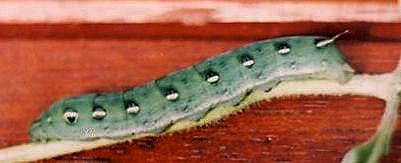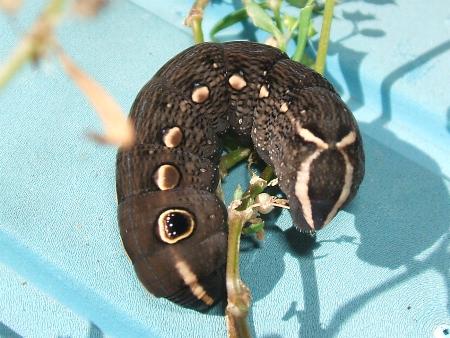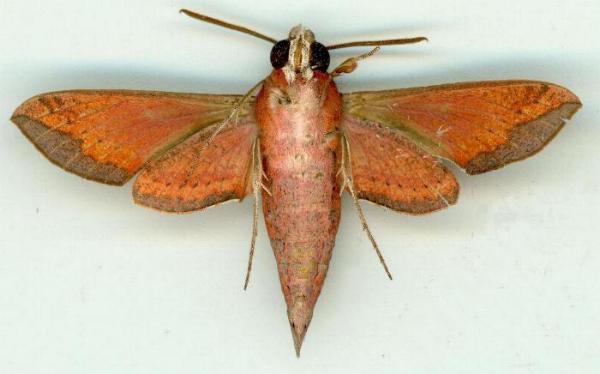
| (one synonym : Hippotion depictum Dupont, 1941) MACROGLOSSINAE, SPHINGIDAE, BOMBYCOIDEA | (donherbisonevans@yahoo.com) and Stella Crossley |

(Photo: courtesy of Tom and David Sleep, Queensland)

| (one synonym : Hippotion depictum Dupont, 1941) MACROGLOSSINAE, SPHINGIDAE, BOMBYCOIDEA | (donherbisonevans@yahoo.com) and Stella Crossley |

(Photo: courtesy of Tom and David Sleep, Queensland)
This caterpillar is either green or brown, and has a dark spike on the tail, which on early instars has a red base. In the first four instars, this spike grows to a length of about 4 mms. For the last (fifth) instar, the spike is shorter with a length of about 2 mms.

Early instars have a off-white eyespot with a black top on the side of each abdominal segemnt. The eyespots on first abdominal segment are larger than the others, and have a black centre with some white dots in it. In the fourth and fifth instars, the eyespots on segments 2 - 7 can have black or brown shading above and/or below the pale centre. Some caterpillars have a pale line up each side the head running over the thorax connecting to a vague pale line that runs through the eyespots to the base of the tail spike, and can form a loop on the back of the claspers.

The caterpillar has been found feeding on various plants in the plant families NEPENTHACEAE and RUBIACEAE, including

The caterpillar grows to a length up to 7 cms. The pupa is silvery brown, with a row of black spots along each side, and a pointed abdominal tip The pupa has a length of about 4 cms. Pupation occurs in tight silk cocoon spun between bits of ground litter.

The adult moths have striped uniformly brown forewings, and red hindwings, each with a brown marginal band extending just past the wingtips. The thorax is dark brown with wide pale dorsal stripe. The abdomen is a uniform pale brown. The wingspan is about 6 cms.

The eggs are off-white and spherical with a diameter of about 1.5 mms. They are laid singly under leaves and buds of a foodplant.
This species occurs over south-east Asia, including
and in Australia, including:


Further reading :
Maxwell S. Moulds, James P. Tuttle and David A. Lane.
Hawkmoths of Australia,
Monographs on Australian Lepidoptera Series, Volume 13 (2020),
pp. 141-145, Plates 31, 77, 87.
Buck Richardson,
Tropical Queensland Wildlife from Dusk to Dawn Science and Art,
LeapFrogOz, Kuranda, 2015, p. 201.
Charles Swinhoe,
Sphinges and Bombyces,
Catalogue of eastern and Australian Lepidoptera Heterocera
in the collection of the Oxford University Museum,
Clarendon Press, Part 1 (1892), pp. 16-17, No. 65.
 caterpillar |  butterflies |  Lepidoptera |  moths |  caterpillar |
(updated 7 November 2011, 9 April 2025)